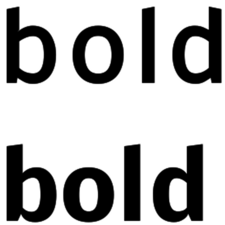LibreOffice: how to avoid manufactured font weights

Off the Beat: Bruce Byfield's Blog
LibreOffice does it. Calligra Suite and Abiword do, too. In fact almost all the word processors you ever used will manufacture bold and italic weights as well as small caps when no font metrics are available. Fortunately, you can work around this over-helpfulness, but you have to be aware of what is happening.
For reasons still unclear to me, LibreOffice varies in its detection of font files. It is not, as I first thought, simply a question of whether font metrics for different weights are stored in one file or several. However, I do know that if you have different weights installed but the toolbar's list of fonts gives only the family name, nothing should be manufactured. By contrast, if the files for some weights are missing, or the weights have separate entries in the font list, then bold and italic weights are manufactured.
As for small capitals, they are usually manufactured whenever small capitals are not included in the font. In the past, I have sometimes seen small caps as a separate entry in the font list, but that seems to have disappeared in recent releases. If small caps are still listed separately for any font, then LibreOffice would presumably manufacture small caps instead of using the real ones.
What's wrong with manufactured fonts?
At first, manufactured weights might seem a benefit. Surely, you might say, they are better than not having the weights available at all?
However, there are at least two reasons for avoiding the use of manufactured fonts.
First, manufactured fonts mean that users are not seeing the font as the designer intended. Font design may be a minor art form, but distorting the design of a font is similar to placing a painting of Van Gogh in a dark corner where his perception of light is hidden by the dimness, or using Auto-Tune in a recording of a singer with a four octave vocal range. If you like a font well enough to use it, you should at least treat its designs with respect.
Most important of all, however, is that manufactured results are almost always a mess. Thickness of character, letter shape, and spacing are jarringly irregular.
Figure 1, for example, shows examples of a manufactured bold weight for the free-licensed font Nobile. The manufactured weight at the top shows none of the subtlety of design of the true bold weight for Nobile, shown at the bottom. The manufactured weight cannot even get the angle right at the top of the "b" and the "d."

Figure 1
Even worse is the manufactured Nobile Italic weight at the top of figure 2. It not only gets the lower case "a" completely wrong, but the angle of the italic is extreme enough to cause reading problems. In fact, I consider the manufactured italic unusable.

Figure 2
However, by far the worst example is the manufactured small capitals in figure 3. They look nothing like the true small caps -- in fact, they could almost be regular capitals by their size, and are hardly worth using.

Figure 3
These examples are all created using LibreOffice. Abiword and Calligra Suite give different results for manufactured weights, but none are significantly better or worse than the ones shown.
What digital typography obscures is that changing the weight of a font is not as easy as a click of the button. In pre-computer typography, even the change in the size of a font was seen as reason to adjust the proportions of individual characters, and adjusting a weight was that much more complicated. Such adjustments are as much an art as a science, and the ability to manufacture different weights would have to be much more sophisticated than it has ever been in any word processor to produce adequate manufactured fonts in even most circumstances. At the very least, the challenge is complicated enough that no one has ever tackled it.
Avoiding manufactured fonts
Anyone who respects artists and cares about the look of their documents should avoid manufactured fonts at all costs. When designing a document, check whether your chosen faults have entries for different weights in LibreOffice's font list.
If they do, avoid creating different weights from the toolbar icons or the Character dialogue window, regardless of whether you are using manual or stylistic formatting.
Instead, create separate character styles for each weight you use. You can create your own styles, or use Emphasis for italics, Strong Emphasis for bold, and Placeholder for small caps. If you always use these character styles, and never change weights from the Regular or Roman version of the font, then manufactured weights should never haunt you.
Follow these guidelines, and manufactured fonts will never create design problems for you. You can forget these relics, consigning them to the oblivion that they deserve.
comments powered by DisqusSubscribe to our Linux Newsletters
Find Linux and Open Source Jobs
Subscribe to our ADMIN Newsletters
Support Our Work
Linux Magazine content is made possible with support from readers like you. Please consider contributing when you’ve found an article to be beneficial.

News
-
Manjaro 26.0 Primary Desktop Environments Default to Wayland
If you want to stick with X.Org, you'll be limited to the desktop environments you can choose.
-
Mozilla Plans to AI-ify Firefox
With a new CEO in control, Mozilla is doubling down on a strategy of trust, all the while leaning into AI.
-
Gnome Says No to AI-Generated Extensions
If you're a developer wanting to create a new Gnome extension, you'd best set aside that AI code generator, because the extension team will have none of that.
-
Parrot OS Switches to KDE Plasma Desktop
Yet another distro is making the move to the KDE Plasma desktop.
-
TUXEDO Announces Gemini 17
TUXEDO Computers has released the fourth generation of its Gemini laptop with plenty of updates.
-
Two New Distros Adopt Enlightenment
MX Moksha and AV Linux 25 join ranks with Bodhi Linux and embrace the Enlightenment desktop.
-
Solus Linux 4.8 Removes Python 2
Solus Linux 4.8 has been released with the latest Linux kernel, updated desktops, and a key removal.
-
Zorin OS 18 Hits over a Million Downloads
If you doubt Linux isn't gaining popularity, you only have to look at Zorin OS's download numbers.
-
TUXEDO Computers Scraps Snapdragon X1E-Based Laptop
Due to issues with a Snapdragon CPU, TUXEDO Computers has cancelled its plans to release a laptop based on this elite hardware.
-
Debian Unleashes Debian Libre Live
Debian Libre Live keeps your machine free of proprietary software.
